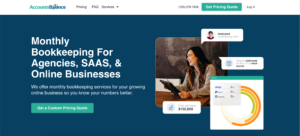
Want to learn about SAAS pricing models?
You’ve come to the right place!
In this article, we’ll break down 8 different pricing models for SAAS companies, the pros and cons of each, and how you can implement them within your SAAS business.
Here’s what we’ll cover:
- Why Is Your SAAS Pricing Model Important?
- 8 SAAS Pricing Models Explained
- #1: Flat Rate Pricing
- #2: Pay Per Use Pricing
- #3: Tiered Pricing
- #4: Usage Based Billing
- #5: License Based Pricing
- #6: Freemium Pricing Model
- #7: Per Active User Pricing
- #8: Per Feature Pricing
- Frequently Asked Questions
Why Is Your SAAS Pricing Model Important?
As a SAAS business owner, your pricing model is one of the most important decisions you will make.
Here’s why:
- It determines your revenue: Your pricing model will directly impact your revenue. Choosing the right pricing strategy can help you generate more revenue while a poorly designed pricing strategy can negatively impact your bottom line.
- It impacts customer acquisition: Your pricing model can either attract or repel potential customers. You need to price your product in a way that customers perceive as valuable and affordable.
- It affects customer retention: Your pricing model can affect your customers’ perceived value of your product and their willingness to continue using it. If your pricing strategy is too expensive or complex, customers may churn.
- It impacts your ability to scale: Your pricing model can affect your ability to scale your business. A pricing model that is too complicated or difficult to manage can slow down your ability to grow your business.
- It influences your competition: Your pricing model can impact your competitive advantage. You need to price your product in a way that is competitive with other products in your market, while also ensuring that you can still make a profit.
8 SAAS Pricing Models Explained
#1: Flat Rate Pricing

Flat rate pricing is a pricing model where a customer pays a fixed fee for a product or service, regardless of how much they use it. This model is common in SAAS businesses that provide a specific set of features or functionality for a fixed price.
Example:
Dropbox is a good example of a SAAS business that uses flat rate pricing. They offer a range of pricing plans, including a basic plan that provides 2GB of storage for free, and paid plans that offer more storage and additional features for a fixed monthly fee.
Pros:
- Easy to understand: Flat rate pricing is simple and straightforward for customers to understand. They know exactly what they will pay and what they will get in return.
- Predictable revenue: With flat rate pricing, you can predict your monthly revenue based on the number of customers you have and their pricing plan. This makes it easier to plan and budget for your business.
- Incentivizes usage: Customers are more likely to use your product if they know that they won’t be charged extra for it. This can help increase customer engagement and retention.
Cons:
- May not be profitable: If your costs to provide the product or service increase as the customer uses it, flat rate pricing may not be profitable for your business. For example, if your storage costs increase as a customer stores more data, your margins may suffer.
- Limits revenue potential: Flat rate pricing may limit your revenue potential if you don’t have additional features or services that you can charge for. Customers may not be willing to pay more for a product that they perceive as a commodity.
- Can be inflexible: Flat rate pricing can be inflexible for customers who have different needs and usage patterns. They may be paying for features they don’t need or want, which can lead to churn.
#2: Pay Per Use Pricing

Pay per use pricing is a model where customers are charged based on how much they use a product or service. This pricing model is common in SAAS businesses that offer products or services with variable usage levels, such as cloud storage or API calls.
Example:
Amazon Web Services (AWS) is a good example of a SAAS business that uses pay per use pricing. They offer a wide range of services, including compute, storage, and database services, that customers can use on a pay per use basis. Customers are charged based on how much they use the service, such as the number of hours they use a virtual machine or the amount of data they store.
Pros:
- Highly flexible: Pay per use pricing allows customers to pay only for what they use, making it highly flexible. Customers can scale their usage up or down based on their needs, without being locked into a fixed pricing plan.
- Potentially more profitable: Pay per use pricing can be more profitable for SAAS businesses if their costs are tied directly to usage. For example, if a cloud storage provider charges customers based on the amount of data they store, they can more accurately price their services to ensure profitability.
- Attractive to cost-conscious customers: Pay per use pricing can be attractive to customers who are cost-conscious and want to avoid paying for features or services they don’t use.
Cons:
- Harder to predict revenue: Pay per use pricing can make it harder to predict revenue, as it is dependent on customer usage. This can make it harder to plan and budget for your business.
- Complex pricing models: Pay per use pricing can result in complex pricing models that can be difficult for customers to understand. This can lead to confusion and potentially churn if customers are not clear on what they are paying for.
- Can be expensive: Pay per use pricing can be more expensive for customers who use a product or service frequently. This can make it less attractive to customers who have high usage levels.
#3: Tiered Pricing

Tiered pricing is a model where customers are offered multiple pricing plans, each with different features and pricing tiers. Typically, as customers move up to higher pricing tiers, they gain access to more features and increased usage limits.
Example:
A popular example of a SAAS business that uses tiered pricing is Mailchimp, an email marketing platform. They offer several pricing plans with different tiers, each with increasing numbers of subscribers and additional features. Customers can choose the pricing plan that best suits their needs and budget.
Pros:
- Increased customer choice: Tiered pricing provides customers with more choice, allowing them to choose a pricing plan that meets their specific needs and budget.
- Potential for increased revenue: Tiered pricing can result in increased revenue for SAAS businesses as customers may be willing to pay more for additional features or increased usage limits.
- Can attract different customer segments: Tiered pricing allows SAAS businesses to cater to different customer segments, such as small businesses and enterprise customers.
Cons:
- Can be complex: Tiered pricing can result in complex pricing plans that can be difficult for customers to understand. This can result in confusion and potentially churn if customers are not clear on what they are paying for.
- May not be suitable for all products: Tiered pricing may not be suitable for all products or services, especially those with limited feature sets or usage limits. In these cases, customers may not see enough value in higher-priced tiers.
- Can be time-consuming to set up: Creating and managing multiple pricing tiers can be time-consuming for SAAS businesses, especially if they have a large number of pricing plans.
#4: Usage Based Billing

Usage-based billing, also known as metered billing, is a pricing model where customers are charged based on their usage of a SAAS product or service. This can include metrics such as the number of API calls, the amount of storage used, or the number of users.
Example:
A popular example of a SAAS business that uses usage-based billing is Twilio, a cloud communications platform. They charge customers based on the number of messages sent, minutes used, and other usage metrics. Customers only pay for what they use, making it a flexible and scalable pricing model.
Pros:
- Fair and flexible pricing: Usage-based billing ensures that customers only pay for what they use, making it a fair and flexible pricing model that can scale with a customer’s usage.
- Encourages customer engagement: By charging customers based on usage, SAAS businesses can encourage customers to engage more with their product or service, which can result in increased usage and revenue.
- Potential for increased revenue: As customers use more of a SAAS product or service, they will be charged more, which can result in increased revenue for SAAS businesses.
Cons:
- Can be difficult to predict revenue: With usage-based billing, revenue can be difficult to predict as it is based on customer usage. This can make it challenging for SAAS businesses to plan and forecast their revenue streams.
- Requires accurate usage tracking: To ensure accurate billing, SAAS businesses must have accurate tracking and reporting of customer usage. This can require additional resources and infrastructure.
- Can be complex: Usage-based billing can be complex, especially if there are multiple usage metrics that need to be tracked and billed. This can result in complex pricing plans that can be difficult for customers to understand.
#5: License Based Pricing

License-based pricing is a pricing model where customers pay a fixed fee to use a SAAS product or service for a specified period of time, usually monthly or annually. This fee typically covers access to all features and functionality of the SAAS product.
Example:
A popular example of a SAAS business that uses license-based pricing is Adobe Creative Cloud, a suite of creative tools for graphic design, video editing, and more. Customers can purchase a monthly or annual license to use the entire suite of products, with the price varying based on the number of users and the plan chosen.
Pros:
- Predictable revenue streams: License-based pricing provides SAAS businesses with a predictable revenue stream, as customers pay a fixed fee on a regular basis.
- Customer retention: By offering a comprehensive suite of products or services, SAAS businesses can encourage customer retention and reduce churn rates.
- Upselling opportunities: License-based pricing can also provide opportunities for upselling, as SAAS businesses can offer higher tier plans with additional features and functionality.
Cons:
- Can be inflexible: License-based pricing can be inflexible for customers who may not need or use all of the features included in the SAAS product or service. This can result in higher costs for customers who only need access to a subset of the features.
- Customer acquisition can be challenging: The upfront cost of a license-based pricing model can make it more challenging to acquire new customers, as they may be hesitant to commit to a long-term subscription without first trying the product or service.
- Difficult to change pricing: Once a license-based pricing model is established, it can be difficult to change pricing without upsetting existing customers who have already committed to a specific plan.
#6: Freemium Pricing Model

The freemium pricing model is a pricing strategy where a basic version of a SAAS product is offered for free, while advanced features or functionality are only available for a fee. The free version of the product is typically limited in some way, such as a limited number of users or reduced functionality.
Example:
One of the most popular examples of a SAAS business that uses the freemium pricing model is Dropbox, a cloud storage and file sharing service. The basic version of Dropbox is free and includes a limited amount of storage, while advanced features such as additional storage and team collaboration tools are available for a fee.
Pros:
- Customer acquisition: The freemium pricing model can be an effective way to acquire new customers, as the free version of the product can serve as a marketing tool to attract users who may eventually upgrade to the paid version.
- Upselling opportunities: By offering a free version of the product with limited functionality, SAAS businesses can provide upselling opportunities to customers who require more advanced features or functionality.
- Customer feedback: The free version of the product can also provide SAAS businesses with valuable customer feedback, which can be used to improve the product and drive future development.
Cons:
- Revenue uncertainty: The freemium pricing model can result in revenue uncertainty, as a significant portion of users may never upgrade to the paid version of the product.
- Costly to support: Offering a free version of the product can be costly to support, as it requires resources to maintain and support both the free and paid versions of the product.
- Customer confusion: The freemium pricing model can also lead to customer confusion and dissatisfaction, as customers may not fully understand the limitations of the free version of the product.
#7: Per Active User Pricing

The per active user pricing model is a pricing strategy where customers are charged based on the number of active users of a SAAS product. An active user is typically defined as a user who has logged into the product within a specified period, such as a month.
Example:
One example of a SAAS business that uses the per active user pricing model is Slack, a popular team communication and collaboration tool. Slack charges customers based on the number of active users on their team, with pricing tiers based on the number of users.
Pros:
- Scalability: The per active user pricing model can be a scalable pricing model for SAAS businesses, as the pricing can be adjusted based on the number of active users.
- Predictable revenue: Since the pricing is based on the number of active users, it can be easier to predict revenue and plan for growth.
- Cost-effective: For customers who have a fluctuating number of users, per active user pricing can be a cost-effective option compared to other pricing models that charge a fixed rate.
Cons:
- Customer dissatisfaction: Customers may be unhappy with per active user pricing if they feel that they are being charged for users who are not actively using the product.
- Complexity: Per active user pricing can be complex to manage and administer, as it requires tracking the number of active users for each customer.
- Limited pricing tiers: Some customers may be deterred by limited pricing tiers, which can result in them seeking out competitors with more flexible pricing options.
#8: Per Feature Pricing

The per feature pricing model is a pricing strategy where customers are charged based on the features of the SAAS product they use. Each feature may have a different cost associated with it, and customers can choose which features they want to use.
Example:
One example of a SAAS business that uses per feature pricing is HubSpot, a marketing and sales automation tool. HubSpot offers a variety of features, such as email marketing, social media management, and CRM, and charges customers based on the features they choose to use.
Pros:
- Customizable pricing: Per feature pricing allows customers to choose the features they want to use, which can make the pricing more customizable and attractive to different segments of customers.
- Higher revenue potential: Since each feature has a separate cost, per feature pricing can potentially lead to higher revenue than other pricing models that charge a flat rate.
- Upselling opportunities: SAAS businesses can use per feature pricing to upsell customers to more advanced features and increase revenue.
Cons:
- Complex pricing: Per feature pricing can be complex and confusing for customers, especially if they have to keep track of the costs of multiple features.
- High upfront cost: Per feature pricing can be expensive for customers who want to use many features, which can deter some potential customers.
- Risk of underuse: Customers may be reluctant to pay for features they don’t use frequently, which can lead to underuse and dissatisfaction with the pricing model.
Frequently Asked Questions
1. What is the 10x rule for SAAS pricing?
The 10x rule for SAAS pricing suggests that the price of a SAAS product should be at least 10 times the cost of delivering it to the customer. This is based on the idea that a SAAS product should provide a significant return on investment for customers, and that pricing should reflect the value it provides. However, the 10x rule is not a hard and fast rule, and pricing should ultimately be based on a combination of factors, including value, competition, and customer needs.
2. What is the typical cost structure of SAAS?
The typical cost structure of SAAS businesses includes the cost of developing and maintaining the software, hosting and infrastructure costs, marketing and sales expenses, and customer support costs. Other costs may include salaries for employees, office space, and legal and accounting fees. The exact cost structure may vary depending on the size and nature of the business, but these are some of the common expenses that SAAS businesses incur.
3. Why is pricing important in SAAS?
Pricing is important in SAAS because it has a direct impact on revenue, profitability, and customer acquisition and retention. Pricing can affect the perceived value of a SAAS product, and can influence the buying decisions of potential customers. Pricing can also impact the competitive landscape, as competitors may have different pricing strategies. As such, choosing the right pricing strategy is critical for the success of a SAAS business.
4. What is the rule of 40 in SAAS?
The Rule of 40 in SAAS is a performance metric that helps assess a SAAS company’s health and growth potential. It states that a SAAS company’s growth rate plus its profit margin should be at least 40%. For example, if a company has a growth rate of 30%, then its profit margin should be at least 10% to meet the Rule of 40. The Rule of 40 is used by investors and analysts to evaluate SAAS companies and determine their potential for long-term success.
5. What is the 80-20 rule in SAAS?
The 80-20 rule in SAAS, also known as the Pareto principle, states that 80% of a company’s revenue comes from 20% of its customers. This principle is based on the idea that a small subset of high-value customers are responsible for the majority of a company’s revenue. Understanding the 80-20 rule can help SAAS businesses focus their marketing and sales efforts on high-value customers, and provide better service and support to these customers to maximize revenue and retention.
6. What is tiered vs. flat pricing?
Tiered pricing is a pricing strategy where a SAAS company offers multiple tiers of service, with each tier having different levels of features and functionality. Customers can choose the tier that best meets their needs and budget. Flat pricing, on the other hand, is a pricing strategy where all customers pay the same price for the same level of service and functionality. Both pricing strategies have their own advantages and disadvantages, and SAAS companies must choose the right pricing model that aligns with their business goals and target customers.
What Is AccountsBalance?

AccountsBalance is a monthly bookkeeping service specialized for agencies & SAAS companies.
We take monthly bookkeeping off your plate and deliver you your financial statements by the 15th or 20th of each month.
You’ll have your Profit and Loss Statement, Balance Sheet, and Cash Flow Statement ready for analysis each month so you and your business partners can make better business decisions.
Interested in learning more? Schedule a call with our CEO, Nathan Hirsch.
And here’s some free resources:
- Entrepreneur Bookkeeping Checklist
- Monthly Finance Meeting Agenda
- SAAS Valuation: 3 Methods to Value SAAS Businesses
- 18 SAAS Marketing Strategies to Scale Faster in 2023
- The SAAS Business Model Explained W/ Examples
In Summary
Feel like you have a grasp on SAAS pricing models now?
If you still have questions, reach out to us at [email protected] and we’ll reply quickly.
Always here to help!
Cheers 🙂









